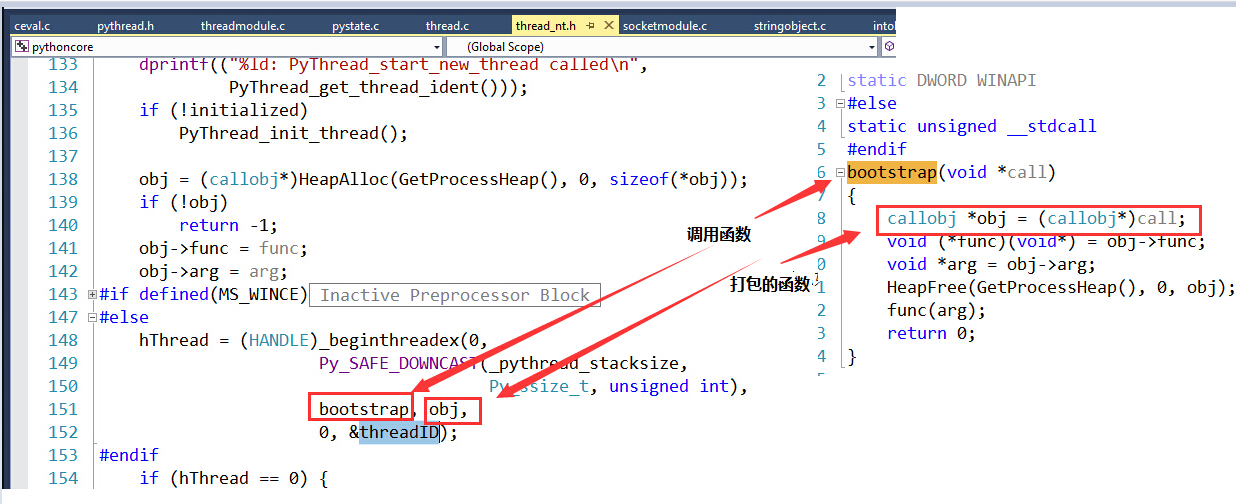Python GIL 多线程机制 (C source code)
最近阅读《Python源码剖析》对进程线程的封装解释:
GIL,Global Interpreter Lock,对于python的多线程机制非常重要,其如何实现的?代码中实现如下:

指向一个void*,C语言中的空指针类型可以指向任意类型。Python建立多线程环境的动作只会执行一次。
PyEval_InitThreads--》PyThread_allocate_lock创建GIL之后,当前线程开始遵守python的多线程机制,即任何调用Python C API之前需要先获得GIL.
也就是代码中PyThread_acquire_lock尝试获取GIL。


static PyMethodDef thread_methods[] = { {"start_new_thread", (PyCFunction)thread_PyThread_start_new_thread, METH_VARARGS, start_new_doc}, {"start_new", (PyCFunction)thread_PyThread_start_new_thread, METH_VARARGS, start_new_doc}, {"allocate_lock", (PyCFunction)thread_PyThread_allocate_lock, METH_NOARGS, allocate_doc}, {"allocate", (PyCFunction)thread_PyThread_allocate_lock, METH_NOARGS, allocate_doc}, {"exit_thread", (PyCFunction)thread_PyThread_exit_thread, METH_NOARGS, exit_doc}, {"exit", (PyCFunction)thread_PyThread_exit_thread, METH_NOARGS, exit_doc}, {"interrupt_main", (PyCFunction)thread_PyThread_interrupt_main, METH_NOARGS, interrupt_doc}, {"get_ident", (PyCFunction)thread_get_ident, METH_NOARGS, get_ident_doc}, {"_count", (PyCFunction)thread__count, METH_NOARGS, _count_doc}, {"stack_size", (PyCFunction)thread_stack_size, METH_VARARGS, stack_size_doc}, {NULL, NULL} /* sentinel */ }; /*创建bootstate,并初始化,其保存关于线程的一切信息,如线程过程,和参数等,*/ static PyObject * thread_PyThread_start_new_thread(PyObject *self, PyObject *fargs) { PyObject *func, *args, *keyw = NULL; struct bootstate *boot; long ident; if (!PyArg_UnpackTuple(fargs, "start_new_thread", 2, 3, &func, &args, &keyw)) return NULL; if (!PyCallable_Check(func)) { PyErr_SetString(PyExc_TypeError, "first arg must be callable"); return NULL; } if (!PyTuple_Check(args)) { PyErr_SetString(PyExc_TypeError, "2nd arg must be a tuple"); return NULL; } if (keyw != NULL && !PyDict_Check(keyw)) { PyErr_SetString(PyExc_TypeError, "optional 3rd arg must be a dictionary"); return NULL; } boot = PyMem_NEW(struct bootstate, 1); if (boot == NULL) return PyErr_NoMemory(); boot->interp = PyThreadState_GET()->interp; boot->func = func; boot->args = args; boot->keyw = keyw; boot->tstate = _PyThreadState_Prealloc(boot->interp); if (boot->tstate == NULL) { PyMem_DEL(boot); return PyErr_NoMemory(); } Py_INCREF(func); Py_INCREF(args); Py_XINCREF(keyw); PyEval_InitThreads(); /* Start the interpreter's thread-awareness */ ident = PyThread_start_new_thread(t_bootstrap, (void*) boot); if (ident == -1) { PyErr_SetString(ThreadError, "can't start new thread"); Py_DECREF(func); Py_DECREF(args); Py_XDECREF(keyw); PyThreadState_Clear(boot->tstate); PyMem_DEL(boot); return NULL; } return PyInt_FromLong(ident); } /*以boot为参数,创建一个原生线程*/ PyThreadState * _PyThreadState_Prealloc(PyInterpreterState *interp) { return new_threadstate(interp, 0); } static PyThreadState * new_threadstate(PyInterpreterState *interp, int init) { PyThreadState *tstate = (PyThreadState *)malloc(sizeof(PyThreadState)); if (_PyThreadState_GetFrame == NULL) _PyThreadState_GetFrame = threadstate_getframe; if (tstate != NULL) { tstate->interp = interp; tstate->frame = NULL; tstate->recursion_depth = 0; tstate->tracing = 0; tstate->use_tracing = 0; tstate->tick_counter = 0; tstate->gilstate_counter = 0; tstate->async_exc = NULL; #ifdef WITH_THREAD tstate->thread_id = PyThread_get_thread_ident(); #else tstate->thread_id = 0; #endif tstate->dict = NULL; tstate->curexc_type = NULL; tstate->curexc_value = NULL; tstate->curexc_traceback = NULL; tstate->exc_type = NULL; tstate->exc_value = NULL; tstate->exc_traceback = NULL; tstate->c_profilefunc = NULL; tstate->c_tracefunc = NULL; tstate->c_profileobj = NULL; tstate->c_traceobj = NULL; tstate->trash_delete_nesting = 0; tstate->trash_delete_later = NULL; if (init) _PyThreadState_Init(tstate); HEAD_LOCK(); tstate->next = interp->tstate_head; interp->tstate_head = tstate; HEAD_UNLOCK(); } return tstate; }
GIL(NRMUTEX)对象,结构中有4个成员,其中hevent就是Win32平台下的Event内核对象,而thread_id则记录任意时刻获取的GIL的线程ID。

1 /* 2 * Lock support. It has too be implemented as semaphores. 3 * I [Dag] tried to implement it with mutex but I could find a way to 4 * tell whether a thread already own the lock or not. 5 */ 6 PyThread_type_lock 7 PyThread_allocate_lock(void) 8 { 9 PNRMUTEX aLock; 10 11 dprintf(("PyThread_allocate_lock called\n")); 12 if (!initialized) 13 PyThread_init_thread(); 14 15 aLock = AllocNonRecursiveMutex() ; 16 17 dprintf(("%ld: PyThread_allocate_lock() -> %p\n", PyThread_get_thread_ident(), aLock)); 18 19 return (PyThread_type_lock) aLock; 20 } 21 22 typedef struct NRMUTEX { 23 LONG owned ; 24 DWORD thread_id ; 25 HANDLE hevent ; 26 } NRMUTEX, *PNRMUTEX ; 27 28 PNRMUTEX 29 AllocNonRecursiveMutex(void) 30 { 31 PNRMUTEX mutex = (PNRMUTEX)malloc(sizeof(NRMUTEX)) ; 32 if (mutex && !InitializeNonRecursiveMutex(mutex)) 33 { 34 free(mutex) ; 35 mutex = NULL ; 36 } 37 return mutex ; 38 } 39 40 BOOL 41 InitializeNonRecursiveMutex(PNRMUTEX mutex) 42 { 43 mutex->owned = -1 ; /* No threads have entered NonRecursiveMutex */ 44 mutex->thread_id = 0 ; 45 mutex->hevent = CreateEvent(NULL, FALSE, FALSE, NULL) ; 46 return mutex->hevent != NULL ; /* TRUE if the mutex is created */ 47 }
PyThread_acquire_lock尝试获取GIL代码如下:

void PyEval_InitThreads(void) { if (interpreter_lock) return; interpreter_lock = PyThread_allocate_lock(); PyThread_acquire_lock(interpreter_lock, 1); main_thread = PyThread_get_thread_ident(); }

/* * Return 1 on success if the lock was acquired * * and 0 if the lock was not acquired. This means a 0 is returned * if the lock has already been acquired by this thread! */ int PyThread_acquire_lock(PyThread_type_lock aLock, int waitflag) { int success ; dprintf(("%ld: PyThread_acquire_lock(%p, %d) called\n", PyThread_get_thread_ident(),aLock, waitflag)); success = aLock && EnterNonRecursiveMutex((PNRMUTEX) aLock, (waitflag ? INFINITE : 0)) == WAIT_OBJECT_0 ; dprintf(("%ld: PyThread_acquire_lock(%p, %d) -> %d\n", PyThread_get_thread_ident(),aLock, waitflag, success)); return success; }
Windown下调用系统的WaitForSingleObject

DWORD EnterNonRecursiveMutex(PNRMUTEX mutex, BOOL wait) { /* Assume that the thread waits successfully */ DWORD ret ; /* InterlockedIncrement(&mutex->owned) == 0 means that no thread currently owns the mutex */ if (!wait) { if (InterlockedCompareExchange(&mutex->owned, 0, -1) != -1) return WAIT_TIMEOUT ; ret = WAIT_OBJECT_0 ; } else ret = InterlockedIncrement(&mutex->owned) ? /* Some thread owns the mutex, let's wait... */ WaitForSingleObject(mutex->hevent, INFINITE) : WAIT_OBJECT_0 ; mutex->thread_id = GetCurrentThreadId() ; /* We own it */ return ret ; }
Linux下则使用互斥锁metux和lock机制,条件等待机制一起使用。
先由本线程调用status = pthread_mutex_lock( &thelock->mut )锁住,mutex保持锁定状态,并在线程挂起进入等待前解锁。
然后status = pthread_cond_wait(&thelock->lock_released,&thelock->mut);
之后status = pthread_mutex_unlock( &thelock->mut );

int PyThread_acquire_lock(PyThread_type_lock lock, int waitflag) { int success; pthread_lock *thelock = (pthread_lock *)lock; int status, error = 0; dprintf(("PyThread_acquire_lock(%p, %d) called\n", lock, waitflag)); status = pthread_mutex_lock( &thelock->mut ); CHECK_STATUS("pthread_mutex_lock[1]"); success = thelock->locked == 0; if ( !success && waitflag ) { /* continue trying until we get the lock */ /* mut must be locked by me -- part of the condition * protocol */ while ( thelock->locked ) { status = pthread_cond_wait(&thelock->lock_released, &thelock->mut); CHECK_STATUS("pthread_cond_wait"); } success = 1; } if (success) thelock->locked = 1; status = pthread_mutex_unlock( &thelock->mut ); CHECK_STATUS("pthread_mutex_unlock[1]"); if (error) success = 0; dprintf(("PyThread_acquire_lock(%p, %d) -> %d\n", lock, waitflag, success)); return success; }

python创建子线程过程:
多线程环境初始化之后,python开始创建底层平台的原生线程。主线程通过调用 thread_PyThread_start_new_thread-》PyThread_start_new_thread完成子线程的工作,返回子线程的ID。子线程的ID只有被激活才能从子线程中获取,因此主线程等待这个子线程的ID,一旦子线程设置好ID,就会设法唤醒主线程。至此,主线程和子线程开始分道扬镳。主线程在返回子线程ID之后,继续执行后续的字节码。
PyThread_start_new_thread传入的func是函数t_bootstrap,而arg则是bootstate结构体boot。而boot中保存着程序中所定义的线程信息。PyThread_start_new_thread首先将func和arg都打包到一个类型为callobj结构体中。
创建好子线程之后,其开始与主线程对GIL竞争。在t_bootstrap中调用PyEval_AcquireThread申请GIL,成功之后就申请到GIL,接下来子线程调用PyEval_CallObjectWithKeywords并最终调用我们熟悉的函数PyEval_EvalFrameEx,也就是python的字节码执行引擎。之后执行完毕,进行清理扫尾工作PyThreadState_DeleteCurrent释放GIL。
t_bootstrap 看上去似乎子线程一直执行到释放GIL,他们是如何激活多线程机制的呢?答案在于函数PyEval_EvalFrameEx中,python内部维护的模拟中断时钟不断激活线程的调度机制,从而实现子线程和主线程的切换。
执行秩序: thread_PyThread_start_new_thread-》PyThread_start_new_thread-》bootstrap--》t_bootstrap
t_bootstrap 代码:

static void t_bootstrap(void *boot_raw) { struct bootstate *boot = (struct bootstate *) boot_raw; PyThreadState *tstate; PyObject *res; tstate = boot->tstate; tstate->thread_id = PyThread_get_thread_ident(); _PyThreadState_Init(tstate); PyEval_AcquireThread(tstate); nb_threads++; res = PyEval_CallObjectWithKeywords( boot->func, boot->args, boot->keyw); if (res == NULL) { if (PyErr_ExceptionMatches(PyExc_SystemExit)) PyErr_Clear(); else { PyObject *file; PyObject *exc, *value, *tb; PyErr_Fetch(&exc, &value, &tb); PySys_WriteStderr( "Unhandled exception in thread started by "); file = PySys_GetObject("stderr"); if (file) PyFile_WriteObject(boot->func, file, 0); else PyObject_Print(boot->func, stderr, 0); PySys_WriteStderr("\n"); PyErr_Restore(exc, value, tb); PyErr_PrintEx(0); } } else Py_DECREF(res); Py_DECREF(boot->func); Py_DECREF(boot->args); Py_XDECREF(boot->keyw); PyMem_DEL(boot_raw); nb_threads--; PyThreadState_Clear(tstate); PyThreadState_DeleteCurrent(); PyThread_exit_thread(); }
完成打包之后,调用Win32下的创建thread API 函数CreateThread或者_beginthreadex ,然后通过bootstrap调用我们定义的函数(例如自己的test.py中的def testThread 函数)
函数打包,调用代码:





 浙公网安备 33010602011771号
浙公网安备 33010602011771号